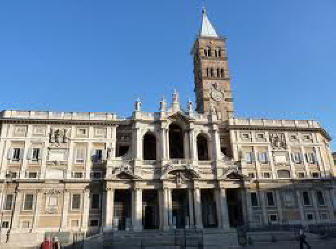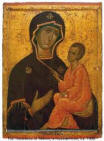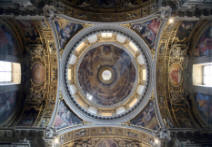|
Treasures of the Church- Holy Sites |
 Basilica of
St. Mary Major Basilica of
St. Mary Major
The Papal Basilica of St. Mary Major
by SCTJM
The Basilica of Saint Mary Major, one of the four great ancient
basilicas in Rome, was founded in the 4th century. This church
stands on the Esquiline hill and its bell tower is the tallest in
Rome. The pilgrim who comes to venerate the Virgin Mary in this
ancient Catholic Basilica, dedicated in her honor, will hardly
experience the same emotion of the previous pilgrims who, by going
up the Esquiline hill, were able to see the Church separated from
the city, rising over palaces and homes. Indeed, the building back
then was not as solemn as the present one, nor as majestic as the
one from the Vatican hill, built by Constantine over Peter=s tomb.
However, it prevailed in its dimension and, above all, in the
purpose for which it was built- it was dedicated to the Holy Virgin
Mary, Mother of Jesus and Mother of all men. The Basilica of Saint
Mary Major owes its true beginnings of history to a particular event
and one man. The Ecumenical Council of Ephesus (431) is the event
where Mary was officially declared the Mother of God. The man is
Sixtus III, the Pope who, several years after this declaration was
made, wanted a Church to be dedicated to the Virgin Mary and to be
built on the Esquiline hill. After more than 1,500 years and despite
the additions and modifications in the interior and exterior, the
Basilica is fundamentally the one of Sixtus II. It is the the most
significant Marian interest in Rome. It is the first, the greatest,
the largest, and the most important Church dedicated to the Mother
of God, the "Theotokos."
The Interior
To the modern pilgrim who enters the
Basilica of Saint Mary Major, it proves to be difficult, if not
impossible, to associate the temple with the early paleochristian
church. Nonetheless, the space, the mosaics of the walls and the
façade of the apse are the antique ones. The surface and the wood
ceiling immediately strike the visitor’s attention due to its
richness and beauty. The first one is a cosmos like style and
although it has been restored various times, it is for the most part
the original of the 12th century. The wood ceiling comes from the
15th century. One tradition, without documented proof, states that
the gold used for the golden decorations of the ceiling were donated
by queen Elizabeth of Castilla.
The Legendary Tale
The narration of the construction of
the first church has legendary origins. The story was told by Friar
Bartolomé de Trento in the 13th century. The friar narrated that a
rich and pious Roman senator named John and his wife, unable to have
any children, had thought of donating their goods and properties to
the Church. The night between the 4th and 5th of August of 358, the
Virgin Mary appeared in their dreams to John and Pope Liberio,
asking them to dedicate a Basilica on the place where snow would
fall that night. The next morning, the rich senator and the Pope
headed towards the Cispio where precisely that night of August it
had snowed prodigiously. In this place, Pope Liberio, before the
presence of a great multitude of faithful, traced over the fresh
snow the plans for the future church, according to the tradition of
the previous arquitects who before beginning the building of a
building, would draw the project over the sand to true scale. That
building, precisely in honor of Pope Liberio was also designated
“Liberiano” and as a remembrance of the event of August 5th, the
liturgical feast of the Virgin Mary is celebrated in Rome and
venerated under the title of “Our Lady of the Snow.”
The Virgin Mary “Salus Populi Romani”
 The
beautiful icon known under the title of “Salvation of the People of
Rome” is one of the images that tradition attributes to the
evangelist Saint Luke and is certainly one of the most venerated in
Rome. According to one legend, Saint Luke was a painter and amongst
the images painted by him, there was a painting of the Virgin Mary.
That is why many artists have represented the evangelist painting
the sweet face of the Mother of God. The legend comes as a result
that Saint Luke, among the evangelists, is the one who narrates more
amply the birth of Jesus and in this context, speaks of the Mother
of the Savior. There are many icons attributed to Saint Luke. The
Virgin of the Basilica of Saint Mary Major is considered the “Virgin
Mary of Saint Luke.” In reality, the icons attributed to him have
all been done in the middle ages. It is said that the popes and the
people of Rome, in the serious moments in its history, had entrusted
themselves to a miraculous image. This image, although it is
impossible to establish its author and the year it was completed, is
an “icon,” that is, the tangible expression that from generation to
generation has been a means of communication with the Virgin Mary.
In this way, the image, apart from its historic-artistic value,
brings to mind the devotion to the Mother of God from hundreds of
generations and the trust they have placed in her intercession
before her Son from whom she obtains liberation from evil and the
biggest calamities. The
beautiful icon known under the title of “Salvation of the People of
Rome” is one of the images that tradition attributes to the
evangelist Saint Luke and is certainly one of the most venerated in
Rome. According to one legend, Saint Luke was a painter and amongst
the images painted by him, there was a painting of the Virgin Mary.
That is why many artists have represented the evangelist painting
the sweet face of the Mother of God. The legend comes as a result
that Saint Luke, among the evangelists, is the one who narrates more
amply the birth of Jesus and in this context, speaks of the Mother
of the Savior. There are many icons attributed to Saint Luke. The
Virgin of the Basilica of Saint Mary Major is considered the “Virgin
Mary of Saint Luke.” In reality, the icons attributed to him have
all been done in the middle ages. It is said that the popes and the
people of Rome, in the serious moments in its history, had entrusted
themselves to a miraculous image. This image, although it is
impossible to establish its author and the year it was completed, is
an “icon,” that is, the tangible expression that from generation to
generation has been a means of communication with the Virgin Mary.
In this way, the image, apart from its historic-artistic value,
brings to mind the devotion to the Mother of God from hundreds of
generations and the trust they have placed in her intercession
before her Son from whom she obtains liberation from evil and the
biggest calamities.
Relics of the Manger
The basilica was formerly titled
“Saint Mary of the Manger” since it preserved some small pieces from
the manger on which the Child Jesus was placed. The crypt found
underneath the main altar represents the heart of the Basilica even
though it is not in the same geometric center. The visual effect the
crypt gives, reminds us of the main events of the Christian faith,
the birth of God made Man and his Mother the Blessed Virgin Mary.
Pius IX, who had on December 8, 1854 proclaimed the dogma of the
Immaculate Conception of Mary, ordered that the reconstruction of
the crypt would be made under the altar of Confession. The richness
of the polychromatic marbles honor the relics of the manger
contained in a precious display case, inside of which Pius VII on
December 23, 1802 had personally placed them. The small pieces,
which tradition and devotion have considered a part of the manger
where the newborn Child Jesus was laid, came to Rome in 642 during
the Pontificate of Pope Theodore I. Origens and Saint Jeronimo in
the 3rd and 4th centuries respectively, say to have seen the Manger
in Bethlehem, precisely in the grotto of the Nativity. Tradition
holds that Jeronimo had been buried in Saint Mary Major and that his
relics would currently be in the sarcophagus of the major altar. It
is beautiful that the Doctor of the Church who translated the texts
of Sacred Scripture from Greek to Latin and who spent various years
of his life in Palestine to be in direct contact with the places
where Jesus lived, rests in this Basilica that in celebrating the
Maternity of Mary, helps to read salvation history from its
beginnings.
Mosaics
In
artistic terms, one of the aspects of great interest in the Basilica
are its mosaics. To examine them by
theme it is necessary to
start
with those of the central nave which are found under the windows and
which were originally 42.
Through the more significant biblical characters who are found on
both walls, all of the Old Testament is narrated. To the left are
Abraham, Isaac, and Jacob, rings of a chain that from generation to
generation lead to the birth of the Messiah. To the right are Moses
and Joshua. In the long walk of 40 years in the desert that took the
hebrew people from slavery in Egypt to the promised Land, one can
read an anticipation of that radical liberation of man that the
Savior would fulfill with his birth, death, and resurrection. The
promises announced in the Old Testament are fulfilled in the person
of Jesus. This theme is described in the mosaics of the triumphant
arc where the cross is raised on high, the final sign of salvation
fulfilled by Christ with his death and resurrection, and witnessed
by the Church represented by the Apostles Peter and Paul at the side
of the throne. The arc of the apse is not original but rather it was
built at the end of the 13th century by Jacopo Torriti. The passing
of the centuries has not put any obstacles to the thematic course of
the early mosaics, but rather it confirms them and gives them value,
underlining that everything that was promised in the Old Testament
and fulfilled in the New finds in Mary its synthesis and culminating
moment. Christ and his Mother are seated on one throne, manifesting
the intimate relationship that unites Mother and Son in the
redemption project of humanity. The Church, represented by the
saints that make up the crown of Christ and the Virgin Mary in her
glorification, contemplates with anticipation the final destination
of all of humanity. This image and its significance synthesize all
of the history of the Basilica of Saint Mary Major. In this basilica
one also finds the tombs of various Popes such as Saint Pius V,
Sixtus V, Clement VIII.
See: Official Site of the Papal Basilica
of St. Mary Major
Back to the
Main Page on Treasures of the Church
This page is the work of the Servants of the Pierced Hearts of Jesus and
Mary
Copyright © 2006- SCTJM
|